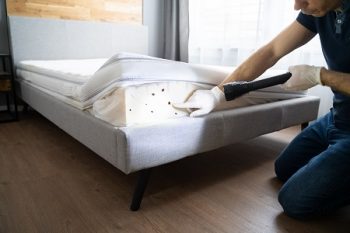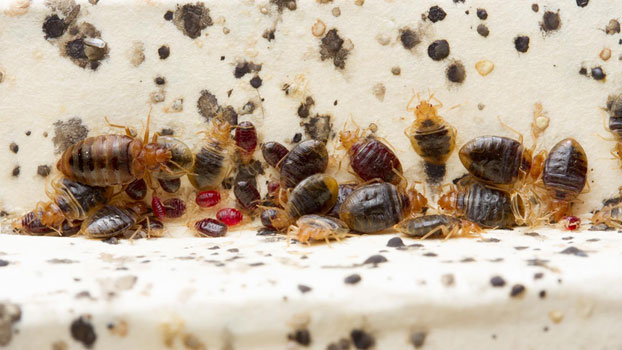The Evolution of Bug Control Providers: Modern Techniques for a Pest-Free Home
From typical pest control techniques to the emergence of green services, the advancement of bug administration solutions has been marked by a continuous quest for a lot more efficient and sustainable techniques. The most fascinating aspect lies in the modern method of incorporated bug management, an all natural method that promises an extensive service to pest control.
Historical Parasite Control Approaches
Throughout background, insect control methods have actually advanced considerably from basic practices to much more innovative strategies. In ancient people, people used natural treatments such as growing specific natural herbs to hinder pests or using pet cats to capture rats. The initial tape-recorded usage of chemicals for insect control dates back to around 2500 BC in Sumeria, where sulfur substances were used to fumigate homes. The Chinese likewise created very early types of insecticides utilizing arsenic and mercury around 1000 BC.
During the Center Ages, pet cats were extremely valued for their parasite control capabilities, resulting in the extensive domestication of these animals. The bubonic plague outbreak in Europe throughout the 14th century triggered the execution of public wellness procedures to control rats and fleas, the providers of the disease. With the industrial transformation came innovations in parasite control, including the development of the very first pesticide, pyrethrum, in the early 19th century. These historical techniques set the foundation for the extra sophisticated bug control techniques we rely upon today.
Emergence of Eco-Friendly Solutions
In current years, there has been a notable shift towards the adoption of green services in the area of bug control. This activity stems from enhancing recognition of the environmental influence of traditional parasite control approaches, which typically include using hazardous chemicals that can pose risks to human health, non-target species, and environments. Eco-friendly parasite control solutions prioritize making use of natural, non-toxic options to efficiently handle bug populaces while minimizing harm to the environment.
One key aspect of environment-friendly bug control is the execution of integrated bug administration (IPM) approaches. IPM concentrates on protecting against and managing bugs through a mix of strategies such as organic control, environment modification, and using environment-friendly items like agricultural insecticides. By targeting the origin of insect problems and utilizing lasting techniques, environment-friendly bug control techniques supply lasting services that are both efficient and eco liable.

Evolution of Parasite Detection Innovation
Advancing at a fast rate, parasite detection technology has gone through significant advancement over the last few years, reinventing the method pest control services operate. Typical methods of bug detection, such as aesthetic evaluations and bait traps, have been supplemented or changed by even more efficient and innovative innovations. One of the most significant advancements is making use of infrared electronic cameras and thermal imaging to discover pests concealed within wall surfaces, ceilings, or other architectural elements. These modern technologies can identify heat trademarks sent out by parasites, offering pest control specialists with useful info on invasion areas without the demand for invasive steps.
Furthermore, the growth of sensing units and screens equipped with expert system has actually made it possible for continuous surveillance of insect activity in business and household rooms. These tools can detect changes in temperature level, moisture levels, and even pest activities, signaling homeowners or insect control firms to possible concerns quickly. Additionally, innovations in remote tracking systems permit real-time information collection and evaluation, improving the precision and efficiency of pest discovery initiatives. In general, the development of pest discovery technology has substantially enhanced the performance and accuracy of insect control solutions, assisting to guarantee pest-free atmospheres for homeowner.
Modern Bug Exclusion Strategies
The evolution of insect detection modern technology has paved the way for the application of modern-day parasite exemption methods, boosting the extensive strategy to pest control services. Modern pest exclusion strategies focus on stopping bugs from going into buildings instead of taking care of invasions after they take place. One key technique is sealing entry factors such as spaces around doors and windows, vents, pipelines, and splits in walls to reject parasites access to interior rooms. Setting up door sweeps, screens, and mesh barriers can additionally successfully obstruct their entrance. Additionally, using fine-mesh metal displays on vents and smokeshafts protects against pests like rodents and birds from infiltrating buildings. Using strategies such as caulking, weatherstripping, and installing barriers like cable mesh during building or renovation can substantially reduce the risk of parasite invasion. By proactively excluding homeowners, parasites and organizations can produce a more resistant defense versus infestations, advertising a pest-free environment and decreasing the need for comprehensive bug control actions.
Integrated Parasite Management Techniques

Tracking is one more important part of IPM, enabling very early detection of parasite task and permitting for timely treatment. When insects are determined, control techniques are applied based on the specific bug species and the level of the invasion.
Verdict
Finally, the evolution of pest control solutions has caused the advancement of even more eco pleasant and efficient strategies for keeping a pest-free home. From standard methods to modern-day technologies, the sector has actually made significant improvements in parasite monitoring, discovery, and exemption. By including incorporated bug monitoring techniques, property owners can currently benefit from a detailed method to keeping bugs at bay, making certain a healthy and balanced and secure living environment.
These tools can find changes in temperature, humidity levels, and also pest activities, signaling property owners or bug control companies to possible concerns quickly. In general, the advancement of bug discovery technology has dramatically improved the performance and precision of parasite control solutions, aiding to ensure pest-free settings for building owners.
The advancement of insect discovery modern technology has actually led the method for the execution of contemporary insect exemption methods, enhancing the detailed technique to pest control philly philadelphia bed bug exterminator services.Integrated Bug Administration Approaches include a holistic method to pest control that emphasizes monitoring, control, and avoidance methods to effectively handle parasite populations (philly exterminator philadelphia pa bed bugs). When insects are recognized, control techniques are applied based on the details bug species and the degree of the invasion